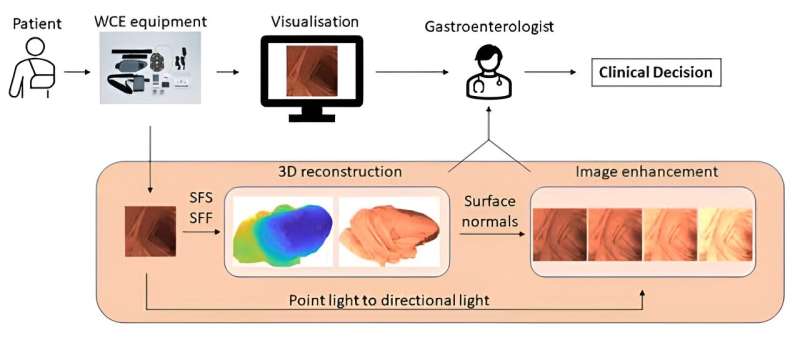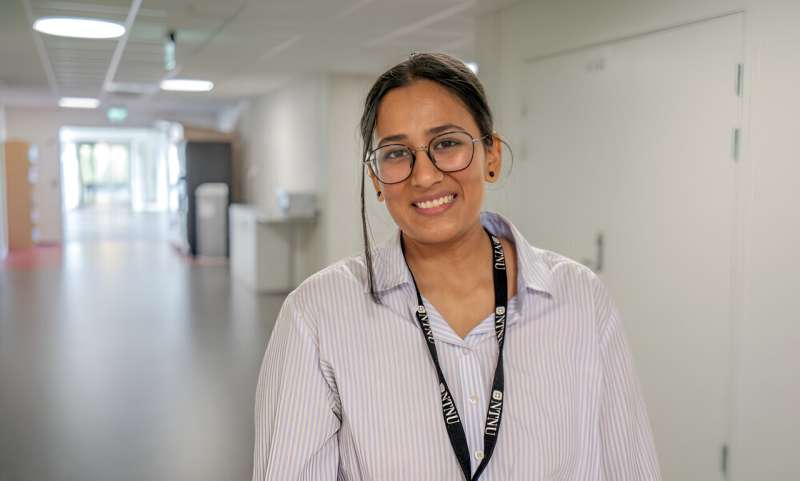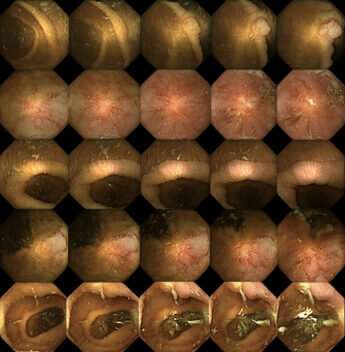This article has been reviewed according to Science X's editorial process and policies. Editors have highlighted the following attributes while ensuring the content's credibility:
fact-checked
trusted source
proofread
Capsule camera of the future can image intestines in 3D and detect disease

Thanks to new technology, a tiny capsule camera can examine your intestines while you get on with your work or walk your dog. Compared with the alternatives, patients experience virtually no discomfort at all.
There are many reasons to choose a capsule camera examination over traditional alternatives such as colonoscopies and gastroscopies
However, there is just one catch: The challenges that for more than 20 years have prevented this smart technology from replacing more invasive examinations have proved more difficult to overcome than many might have hoped and believed.
Here are two research pathways that will change this—and the explanation of how they are connected.
The intestines minute by minute
The capsule spends an average of eight hours traveling through the digestive system. During its journey, it covers about the same number of meters and records more than 50,000 images.
"It goes without saying that analyzing such a wealth of data is a very resource-intensive task," says scientist Pål Anders Floor. He works at the Department of Computer Science at NTNU in Gjøvik.
In recent years, he has been looking into the possibility of using a capsule camera to create a three-dimensional representation of the intestine. He has published his work in IEEE Access.
"In combination with machine learning, a 3D reconstruction can quickly draw the specialist's attention to possible diseases and other anomalies. As a result, no one has to sit and stare at the capsule camera's tedious journey through the digestive tract minute by minute," says Floor.
Imaging in fits and starts
Not only is the current method of examination time-consuming, but there is also a not-insignificant chance that disease might not be detected.
In exactly the same way as the food you eat, capsule cameras are at the mercy of the intestines as soon as you swallow them. This means that the capsule might be completely still one moment, and then suddenly shoot off the next. Unlike an endoscope which is controlled by a specialist—the capsule camera does not take time to stop and make sure it has taken good enough pictures of a polyp before it moves on.
"In some cases, it only manages to take a single picture of the diseased area in passing, and due to unstable light conditions, bubbles and other interfering elements, there is no guarantee that the diseased area will be clearly visible in that one picture," says Floor.
He believes artificial intelligence and machine learning can improve the situation.
Machine learning can improve capsule cameras
The use of machine learning has led to several breakthroughs in the detection of diseases in recent years, and the gastrointestinal region is no exception in this respect. In fact, computers have already proven to be as good as or better than specialists at detecting some diseases based on capsule camera images.
However, the computers still have certain weaknesses. For example, they are very poor at distinguishing between different diseases.
"This is partly due to a lack of data that can be used to train algorithms," says scientist Anuja Vats.
She works at the same department as Floor and specializes in how machine learning can make capsule cameras better at detecting diseases despite the lack of data. She has published research in Scientific Reports.

Training algorithms using artificial data
Machine learning requires data—large volumes of data—and since health information is subject to very strict data protection regulations, scientists cannot just pick and choose from capsule camera recordings. In addition, the recordings that are actually available usually only show one specific stage of a disease. To be absolutely sure that the algorithms actually identify these diseases, they need to be trained in the entire course of the disease.
"If large amounts of data had been readily available, it would still have required us to involve many experts for long periods to categorize them for us. We have therefore looked at the possibility of training the algorithms using artificial data," explains Vats.

Creating artificial images of intestinal diseases
No sooner said than done! Using a so-called machine learning framework developed by scientists from the US video card manufacturer Nvidia, Vats and her colleagues have now created a series of artificial images of a selection of intestinal diseases in their various stages.
Before they could feed the capsule camera algorithms with the results, they had to make sure they were realistic enough.
Gastrointestinal specialists were shown the images, and they were largely unable to distinguish between the real images and the images developed by artificial intelligence.
"One of the major obstacles to creating a good training program for capsule endoscopy is the lack of a good atlas with an overview of diseases in their different stages. These results make it possible to develop these kinds of atlases using artificially generated images," explains Vats.
Complementing each other
Although their approaches are relatively different, there are strong indications that the scientific work being done by Pål Anders Floor and Anuja Vats may complement each other.
"By combining machine learning techniques that identify diseases and 3D models of the intestines, we will get a tool that not only contributes to improved and less resource-intensive capsule camera examinations, but one that can also be used in operations," Floor explains.
He envisions several ways in which the tool can assist practicing clinicians.
"By enabling surgeons to inspect the individual patients' intestines in advance, it can be used to plan and practice prior to particularly difficult procedures. As a result, the risk of something going wrong can be reduced," says Floor.
This may be particularly relevant in light of a new study from North Carolina State University. The study claims that not all intestines are created equal. The nature and anatomy of the digestive tract seem to vary greatly, even among healthy individuals.
Despite promising results, however, both scientists emphasize that there is still work to be done before the capsule cameras can replace other types of examinations altogether. And maybe that is not a goal in itself, either.
"The most important thing is to be able to offer a comfortable alternative to people who are reluctant to undergo more invasive intestinal examinations. Some of these examinations are associated with so much discomfort that many people simply don't go to get examined," says Vats.
More information: Bilal Ahmad et al, 3D Reconstruction of Gastrointestinal Regions Using Single-View Methods, IEEE Access (2023). DOI: 10.1109/ACCESS.2023.3286937
Anuja Vats et al, Evaluating clinical diversity and plausibility of synthetic capsule endoscopic images, Scientific Reports (2023). DOI: 10.1038/s41598-023-36883-x





















